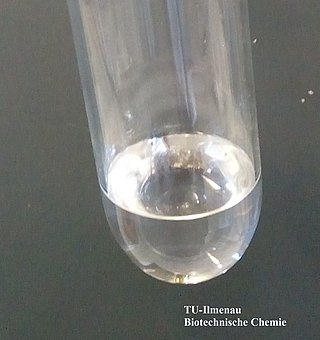Related Research Articles
The data values of standard electrode potentials (E°) are given in the table below, in volts relative to the standard hydrogen electrode, and are for the following conditions:

Lithium hydroxide is an inorganic compound with the formula LiOH. It can exist as anhydrous or hydrated, and both forms are white hygroscopic solids. They are soluble in water and slightly soluble in ethanol. Both are available commercially. While classified as a strong base, lithium hydroxide is the weakest known alkali metal hydroxide.
Elastic properties describe the reversible deformation of a material to an applied stress. They are a subset of the material properties that provide a quantitative description of the characteristics of a material, like its strength.

2,2,6,6-Tetramethylpiperidine, abbreviated TMP, HTMP, or TMPH, is an organic compound of the amine class. In appearance, it is a colorless liquid and has a "fishy", amine-like odor. This amine is used in chemistry as a hindered base. Although TMP finds limited use per se, its derivatives are a mainstay of hindered amine light stabilizers.

Caesium hydroxide is a strong base containing the highly reactive alkali metal caesium, much like the other alkali metal hydroxides such as sodium hydroxide and potassium hydroxide. Caesium hydroxide is corrosive enough to quickly dissolve through glass.
The speed of sound in any chemical element in the fluid phase has one temperature-dependent value. In the solid phase, different types of sound wave may be propagated, each with its own speed: among these types of wave are longitudinal, transversal, and extensional.
Polonium (84Po) has 42 isotopes, all of which are radioactive, with between 186 and 227 nucleons. 210Po with a half-life of 138.376 days has the longest half-life of naturally occurring polonium. 209Po, with a half-life of 125.2 years, has the longest half-life of all isotopes of polonium. 209Po and 208Po can be made through proton bombardment of bismuth in a cyclotron.

Germanium tetrachloride is a colourless, fuming liquid with a peculiar, acidic odour. It is used as an intermediate in the production of purified germanium metal. In recent years, GeCl4 usage has increased substantially due to its use as a reagent for fiber optic production.
This page provides supplementary chemical data on calcium hydroxide.
This page provides supplementary chemical data on chloroform.
This page provides supplementary data about the noble gases, which were excluded from the main article to conserve space and preserve focus. Oganesson mostly not included due to the amount of research known about it.

Tripalmitin is a triglyceride derived from the fatty acid palmitic acid.

Gadolinium diiodide is an inorganic compound, with the chemical formula of GdI2. It is an electride, with the ionic formula of Gd3+(I−)2e−, and therefore not a true gadolinium(II) compound. It is ferromagnetic at 276 K with a saturation magnetization of 7.3 B; it exhibits a large negative magnetoresistance (~70%) at 7 T near room temperature. It can be obtained by reacting gadolinium and gadolinium(III) iodide at a high temperature:
References
- 1 2 3 4 CRC handbook of chemistry and physics : a ready-reference book of chemical and physical data . Lide, David R. (84th ed.). Boca Raton, Fla.: CRC Press. 2003. pp. 4–44. ISBN 0849304849. OCLC 52548731.
{{cite book}}: CS1 maint: others (link) - ↑ CRC handbook of chemistry and physics : a ready-reference book of chemical and physical data. Lide, David R. (84th ed.). Boca Raton, Fla.: CRC Press. 2003. ISBN 0849304849. OCLC 52548731.
{{cite book}}: CS1 maint: others (link)
- Linstrom, Peter J.; Mallard, William G. (eds.); NIST Chemistry WebBook, NIST Standard Reference Database Number 69, National Institute of Standards and Technology, Gaithersburg (MD)
- Except where noted otherwise, data relate to Standard temperature and pressure.
- Reliability of data general note.